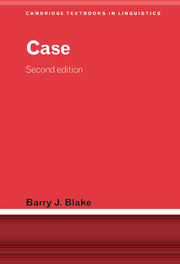Book contents
- Frontmatter
- Contents
- List of figures
- List of tables
- Preface to the Second Edition
- Preface to the First Edition
- List of abbreviations
- 1 Overview
- 2 Problems in describing case systems
- 3 Modern approaches to case
- 4 Distribution of case marking
- 5 Survey of case marking
- 6 Life cycle of case systems
- Notes
- Guide to terminology
- Guide to further reading
- References
- Author index
- Language index
- Subject index
3 - Modern approaches to case
Published online by Cambridge University Press: 05 June 2012
- Frontmatter
- Contents
- List of figures
- List of tables
- Preface to the Second Edition
- Preface to the First Edition
- List of abbreviations
- 1 Overview
- 2 Problems in describing case systems
- 3 Modern approaches to case
- 4 Distribution of case marking
- 5 Survey of case marking
- 6 Life cycle of case systems
- Notes
- Guide to terminology
- Guide to further reading
- References
- Author index
- Language index
- Subject index
Summary
Introduction
This chapter deals with themes that have come to the fore over the course of the last forty years. Since the early sixties linguistics has been dominated by the theories of Chomsky. His influence is evident not only in works couched in a Chomskian framework, but in the Case Grammar of Fillmore, the Relational Grammar of Perlmutter and Postal and the Lexical–Functional Grammar of Bresnan. These theories and indeed most of the thirty-odd theories that have been advanced over the last few decades have been provoked by and are a reaction to some facet of Chomsky's theoretical approach.
At the beginning of chapter 1 case was described as essentially a system for marking dependent nouns for the type of relationship they bear to their heads. It was pointed out that the term case traditionally referred to inflectional marking (section 1.1), but could be extended to cover prepositions and postpositions (section 1.2). Other means of signalling the type of relationship dependent nouns bear to their heads, such as word order, were referred to as ‘competing mechanisms’ (section 1.3). In recent theories the view has emerged, foreshadowed in Hjelmslev (1935: 21), that all these mechanisms may be used to signal case, that case is abstract existing independently of the means of expression, that it is universal. This view is described in section 3.3 below.
- Type
- Chapter
- Information
- Case , pp. 47 - 92Publisher: Cambridge University PressPrint publication year: 2001



